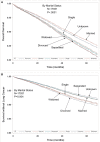The Role of Race and Economic Characteristics in the Presentation and Survival of Patients With Surgically Resected Non-Small Cell Lung Cancer
- PMID: 29868470
- PMCID: PMC5960810
- DOI: 10.3389/fonc.2018.00146
The Role of Race and Economic Characteristics in the Presentation and Survival of Patients With Surgically Resected Non-Small Cell Lung Cancer
Abstract
Background: Little is understood regarding the inter-relation between economic, marital, and racial/ethnic differences in presentation and survival of surgically resected lung cancer patients. Our investigation will assess these differences in addition to known therapeutic, patient, and histopathologic factors.
Methods: A retrospective review of the Surveillance Epidemiology and End Reporting database was conducted through the years 2007-2012. The population was split into nine different ethnic groups. Population differences were assessed via chi-square testing. Multivariable analysis (MVA) were used to detect overall survival (OS) differences in the total surgical population (TS, N = 35,689) in an ear (T1-T2 < 4 cm N0) surgical population [early-stage resectable (ESR), N = 17,931]. Lung cancer-specific survival (LCSS) was assessed in the ESR.
Results: In the TS population, as compared to Whites, Blacks, and Hispanics presented with younger age, more adenocarcinomas, lower rates of marriage, lower rates of insurance, less stage I tumors, and had less nodes examined, but their type of surgical procedures and OS/LCSS were the same. MVA demonstrated that lower OS and LCSS were associated with males, single/divorced/widowed partnership, lower income (TS only), and Medicaid insurance. MVA also found that Blacks and Hispanics had a similar OS/LCSS to Whites and that all ethnic groups were associated with a similar or better outcomes. The 90-day mortality and positive nodes were correlated with not having insurance and not being married, but they were not associated with ethnicity.
Conclusion: In TS and ESR groups, OS was not different in the two largest ethnic groups (Black and Hispanic) as compared to Whites, but was related to single/widowed/divorced status, Medicaid insurance, and income (TS group only). Nodal positivity was associated with patients who did not have a married partner or insurance suggesting that these factors may impact disease biology. Economic and psychosocial variables may play a role in survival of ear lung cancer in addition to standard histopathologic and treatment variables.
Keywords: lung cancer; marital status; racial differences; socioeconomic status; surgical resection.
Figures



Similar articles
-
Population-based differences in the outcome and presentation of lung cancer patients based upon racial, histologic, and economic factors in all lung patients and those with metastatic disease.Cancer Med. 2018 Apr;7(4):1211-1220. doi: 10.1002/cam4.1430. Epub 2018 Mar 13. Cancer Med. 2018. PMID: 29533006 Free PMC article.
-
Exploration of the optimal number of regional lymph nodes removed for resected N0 NSCLC patients: A population-based study.Front Oncol. 2022 Sep 29;12:1011091. doi: 10.3389/fonc.2022.1011091. eCollection 2022. Front Oncol. 2022. PMID: 36249000 Free PMC article.
-
Survival outcomes for lung neuroendocrine tumors in California differ by sociodemographic factors.Endocr Relat Cancer. 2023 Dec 8;31(1):e230068. doi: 10.1530/ERC-23-0068. Print 2024 Jan 1. Endocr Relat Cancer. 2023. PMID: 37882324 Free PMC article.
-
The rates of second lung cancers and the survival of surgically-resected second primary lung cancers in patients undergoing resection of an initial primary lung cancer.Lung Cancer. 2020 Sep;147:115-122. doi: 10.1016/j.lungcan.2020.07.015. Epub 2020 Jul 15. Lung Cancer. 2020. PMID: 32688194
-
Survival Following Segmentectomy or Lobectomy in Patients With Stage IB Non-small-cell Lung Cancer.Front Oncol. 2020 May 15;10:661. doi: 10.3389/fonc.2020.00661. eCollection 2020. Front Oncol. 2020. PMID: 32500023 Free PMC article.
Cited by
-
A novel nomogram for predicting cancer-specific survival in women with uterine sarcoma: a large population-based study.BMC Womens Health. 2022 May 14;22(1):175. doi: 10.1186/s12905-022-01739-5. BMC Womens Health. 2022. PMID: 35568940 Free PMC article. Clinical Trial.
-
Ethnic Differences in Survival Among Lung Cancer Patients: A Systematic Review.JNCI Cancer Spectr. 2021 Jul 7;5(5):pkab062. doi: 10.1093/jncics/pkab062. eCollection 2021 Oct. JNCI Cancer Spectr. 2021. PMID: 34485813 Free PMC article.
-
Clinicopathological characteristics and prediction of cancer-specific survival in large cell lung cancer: a population-based study.J Thorac Dis. 2020 May;12(5):2261-2269. doi: 10.21037/jtd.2020.04.24. J Thorac Dis. 2020. PMID: 32642131 Free PMC article.
-
Meta-Analysis of Rates and Risk Factors for Local Recurrence in Surgically Resected Patients With NSCLC and Differences Between Asian and Non-Asian Populations.JTO Clin Res Rep. 2023 Apr 6;4(10):100515. doi: 10.1016/j.jtocrr.2023.100515. eCollection 2023 Oct. JTO Clin Res Rep. 2023. PMID: 37753322 Free PMC article.
-
The Incidence of Node-Positive Non-small-Cell Lung Cancer Undergoing Sublobar Resection and the Role of Radiation in Its Management.Front Oncol. 2020 May 26;10:417. doi: 10.3389/fonc.2020.00417. eCollection 2020. Front Oncol. 2020. PMID: 32528866 Free PMC article.
References
-
- National Comprehensive Cancer Network guidelines. Available from: http://www.nccn.org/professionals/physician_gls/f_guidelines.asp (Accessed: November 22, 2016).
LinkOut - more resources
Full Text Sources
Other Literature Sources
Miscellaneous

